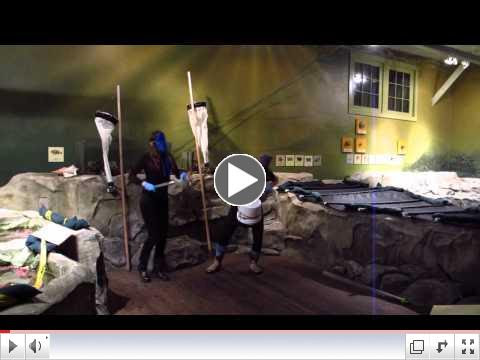Communication is not usually something we think about past grade
school. We learn to read, write, converse, but once we've learned we just start
using these skills without much additional thought. Words have a huge impact on
people, and I've noticed that when I am trying to communicate environmental
issues to the public I now think more carefully about how my words will mold
their experience.
The Port Townsend Marine Science Center is going through many changes this year as we are designing and building new exhibits (made possible by a Public Participation Grant from the WA Department of Ecology). New exhibits also give us an opportunity to re-think how we communicate tough environmental issues. One of the first exhibits to get a face lift was a panel that was previously titled “Am I Contaminated Too?” A picture of a little girl stared down at visitors surrounded by paragraphs about toxic chemicals that have been leaching from our industrialized lives into the environment and our own bodies. It was very grim. Our volunteer docents even avoided talking about the panel with visitors because of its negative tone and wordiness. We spent many hours designing the old exhibit, but it just wasn't an image that inspired people into action.
Change came in the form of our “Be A Toxic Free Zone” workshop, a free program that the Science Center has been providing for members of the Port Townsend community. My role was to help the design team translate the workshop’s emphasis on personal and community actions into a new interactive panel (briefly mentioned in an October Blog post). Many design and text iterations later we came up with a magnetic panel that invited visitors to replace toxic household items with non-toxic alternatives. Lo and behold, the panel has been a success! Volunteers and visitors now engage with the new panel and try their hand at making their world a “toxic free zone.”
AmeriCorps Member Allison Kellum installs “Be a Toxic Free
Zone” interpretive panel
in the Natural History Exhibit with PTMSC staff Phil
Dinsmore and Jean Walat.
There has also been a large amount of crossover between workshop participants and exhibit docents. People have been so impacted by what they learned about toxics in the workshop that they are now sharing what they learned with others. To help them communicate these ideas, they are using the new display to illustrate actions that we can all take to help the Salish Sea.
I hone my communication skills every day when I type up an e-mail or
catch up with a volunteer, but it’s been incredible to learn how strategic
framing can take a conversation from negative to positive, from apathy to
action.
by Allison Kellum, AmeriCorps - Natural History and Volunteer Educator
This Blog post is from a "Story of Service" submission to AmeriCorps and the Corporation for National and Community Service. We have four AmeriCorps Members serving for the '14-'15 term at the Science Center and they are deeply involved in almost every aspect of the organization.
by Allison Kellum, AmeriCorps - Natural History and Volunteer Educator
This Blog post is from a "Story of Service" submission to AmeriCorps and the Corporation for National and Community Service. We have four AmeriCorps Members serving for the '14-'15 term at the Science Center and they are deeply involved in almost every aspect of the organization.



































.bmp)



